The AMD Radeon R7 265 & R7 260 Review: Feat Sapphire & Asus
by Ryan Smith on February 13, 2014 8:00 AM ESTCompute
Jumping into compute, we’re once again treading into familar territory. Pitcairn and Bonaire are Pitcairn and Bonaire, so this will result in the same general performance differences we've seen elsewhere.
As always we'll start with our DirectCompute game example, Civilization V, which uses DirectCompute to decompress textures on the fly. Civ V includes a sub-benchmark that exclusively tests the speed of their texture decompression algorithm by repeatedly decompressing the textures required for one of the game’s leader scenes. While DirectCompute is used in many games, this is one of the only games with a benchmark that can isolate the use of DirectCompute and its resulting performance.
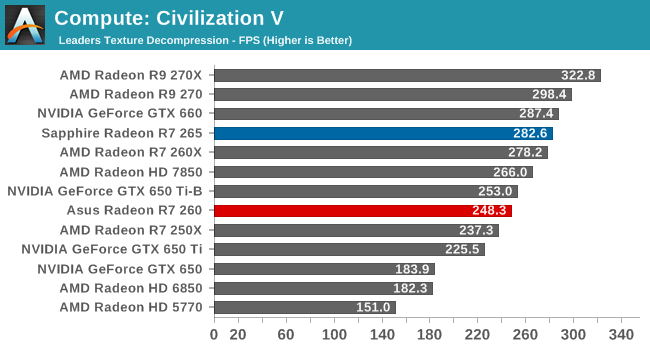
Similar to the 3DMark pixel throughput test on the last page, the Civilization V texture decompression tests highlights the fact that the R7 265 and R7 260X are closer than one would expect in certain edge cases. Once again the R7 260X’s higher clockspeed is helping it keep the gap between it and the R7 265 very narrow, as the two have very similar shader throughput in the end.

The story is much the same with LuxMark as it was Civilization V, with AMD cards once again being sorted almost exactly by shader throughput. Though it’s worth pointing out that NVIDIA’s performance under LuxMark has greatly improved as of the R334 drivers. It’s not enough to close the gap with AMD, but it’s closer than it once was.

Like LuxMark, Sony Vegas is a benchmark dominated by AMD. The lead here is so great that the R7 265 could run this benchmark twice over before the GTX 660 completed it once. Nor would the R7 260 be too far behind in that respect.
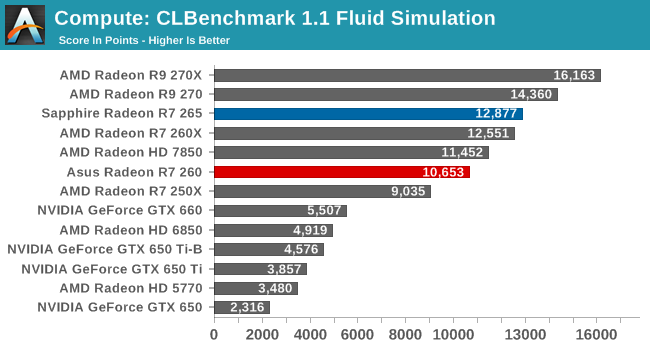

Both CLBenchmark’s fluid simulation benchmark and the computer vision benchmark go to AMD here. The GTX 650 Ti and GTX 660 are not competitive here.
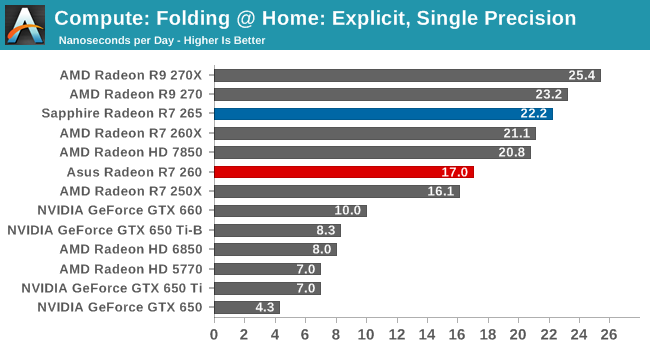
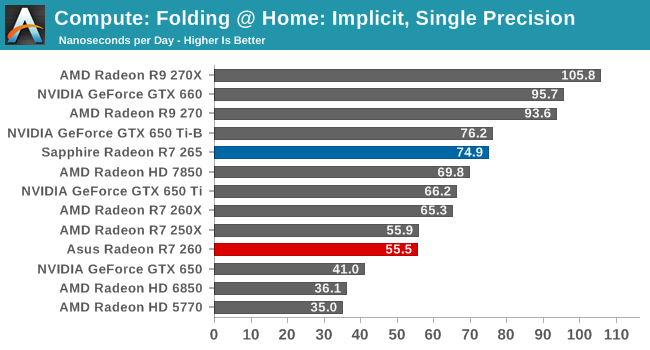
With AMD’s Catalyst 14.1 drivers, AMD has been able to increase their Folding @ Home performance by several percent, closing some gaps while widening others. In the Explicit SP benchmark AMD further increases their lead here, with even the lowly R7 250X holding a significant lead over the GTX 660. On the other hand the R7 265 can’t come close to the GTX 660 under Implicit SP; there’s a lack of raw shader throughput to make it happen.
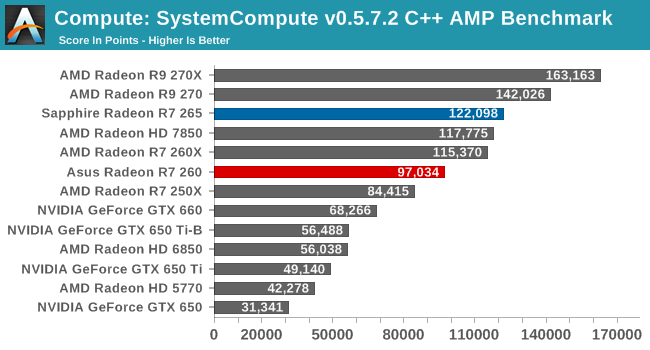
SystemCompute is another compute benchmark that goes to AMD. The R7 265 and R7 260 handily beat the GTX 660, never mind the GTX 650 Ti.










52 Comments
View All Comments
Death666Angel - Thursday, February 13, 2014 - link
Who is surprised by that? No one that is following GPU reviews since multi-monitors became a thing for the consumer crowd. The first few generations had issues with monitors flickering in a multi-monitor setup because of too aggressive down clocking, so now they are being very conservative there and increase the clocks quite a bit.Solid State Brain - Thursday, February 13, 2014 - link
I don't think it's acceptable, though. AMD might have reduced idle consumption when a single monitor is being driven, but is still neglecting other usage scenarios that are becoming increasingly common. It's not even just a small power difference, especially with medium to high-end video cards.Da W - Thursday, February 13, 2014 - link
STFU.Anandtech had no problem calling 290 - 290X a terrible card because of its blower and the NOISE and crowning Nvidia once again. Much more now with AMD price hike.
The only biased guy here is YOU Nvidia fanboy.
silverblue - Thursday, February 13, 2014 - link
I don't think the price hikes are AMD's fault per se, however considering the inflated prices due to bitmining, you'd definitely want a better cooler than the stock one. The third party cards handle this nicely.Da W - Thursday, February 13, 2014 - link
My last post was directed to HisDivineOrder but the reply button doesn't seem to place my reply below his post.formulav8 - Thursday, February 13, 2014 - link
They always complain when something good is said about AMD whether the good is justified or not justified. They don't care either way.SolMiester - Thursday, February 13, 2014 - link
If this is just the 7xxx rebadge, then I guess it has the same multi GPU frame pacing issues....LOL, why dont they fix the damn thing FFS!...no CF Eyefinity, no DX9 pacing.....still shit!fiasse - Thursday, February 13, 2014 - link
Typo 'and R7 270 holding at $179 (MSRP)'Mr Perfect - Thursday, February 13, 2014 - link
With the naming of the card being so close to the 260X, I was really hoping this would be a faster GN1.1 part. How does AMD expect TrueAudio to catch on if they keep releasing card that don't support it? Hopefully the 300 series will sort this out and I can grab one to play Thief on.fiasse - Thursday, February 13, 2014 - link
looks like another typo on Asus R7 260 page, 'but this is an especially treacherous position if R7 260X prices quickly come down to $199.'